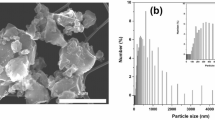Abstract
Silicon has been investigated intensively as a promising anode material for rechargeable lithium-ion batteries. The choice of a binder is very important to solve the problem of the large capacity fade observed along cycling. The effect of modified elastomeric binders on the electrochemical performance of crystalline nano-silicon powders was studied. Compared with the conventional binder (polyvinylidene fluoride (PVDF)), Si electrodes using the elastomeric styrene butadiene rubber (SBR) and sodium carboxymethyl cellulose (SCMC) combined binder show an improved cycling performance. The reversible capacity of the Si electrode with the SCMC/SBR binder is as high as 2221 mA·h/g for 30 cycles in a voltage window between 0.005 and 2 V. The structure changes from SEM images of the silicon electrodes with different binders were used to explore the property improvement.
Similar content being viewed by others
References
M. Holzapfel, H. Buqa, W. Scheifele, P. Novak, and F.M. Petrat, A new type of nano-sized silicon/carbon composite electrode for reversible lithium insertion, Chem. Commun., 2005, No.12, p.1566.
R.A. Sharma and R.N. Seefurth, Thermodynamic properties of the lithium-silicon system, J. Electrochem. Soc., 123(1976), p.1763.
J.R. Owen, Rechargeable lithium batteries, Chem. Soc. Rev., 26(1997), p.259.
Q. Ru, Q. Tian, S.J. Hu, and L.Z. Zhao, Lithium intercalation mechanism for β-SnSb in Sn-Sb thin films, Int. J. Miner. Metall. Mater., 18(2011), p.216.
U. Kasavajjula, C. Wang, and A.J. Appleby, Nano- and bulk-silicon-based insertion anodes for lithium-ion secondary cells, J. Power Sources, 163(2007), p.1003.
W.J. Zhang, A review of the electrochemical performance of alloy anodes for lithium-ion batteries, J. Power Sources, 196(2011), p.13.
W.J. Zhang, Lithium insertion/extraction mechanism in alloy anodes for lithium-ion batteries, J. Power Sources, 196(2011), p.877.
D. Munao, J. van Erven, M. Valvo, E. Garcia-Tamayo, and E. Kelder, Role of the binder on the failure mechanism of Si nano-composite electrodes for Li-ion batteries, J. Power Sources, 196(2011), p.6695.
Z. Chen, V. Chevrier, L. Christensen, and J.R. Dahn, Design of amorphous alloy electrodes for li-ion batteries, Electrochem. Solid State Lett., 7(2004), p.A310.
O. Crosnier, X. Devaux, T. Brousse, P. Fragnaud, and D.M. Schleich, Influence of particle size and matrix in “metal” anodes for Li-ion cells, J. Power Sources, 97–98(2001), p.188.
H. Buqa, M. Holzapfel, F. Krumeich, C. Veit, and P. Novák, Study of styrene butadiene rubber and sodium methyl cellulose as binder for negative electrodes in lithium-ion batteries, J. Power Sources, 161(2006), p.617.
W.R. Liu, M.H. Yang, H.C. Wu, S.M. Chiao, and N.L. Wu, Enhanced cycle life of si anode for li-Ion batteries by using modified elastomeric binder, Electrochem. Solid State Lett., 8(2005), p.A100.
J. Li, R.B. Lewis, and J.R. Dahn, Sodium carboxymethyl cellulose, Electrochem. Solid State Lett., 10(2007), p.A17.
B. Lestriez, S. Bahri, I. Sandu, L. Roué, and D. Guyomard, On the binding mechanism of CMC in Si negative electrodes for Li-ion batteries, Electrochem. Commun., 9(2007), p.2801.
N.S. Hochgatterer, M.R. Schweiger, S. Koller, P.R. Raimann, T. Wöhrle, C. Wurm, and M. Winter, Silicon/graphite composite electrodes for high-capacity anodes: influence of binder chemistry on cycling stability, Electrochem. Solid State Lett., 11(2008), p.A76.
Author information
Authors and Affiliations
Corresponding author
Additional information
This work was financially supported by the National Natural Science Foundation of China (No.51004016).
Rights and permissions
About this article
Cite this article
Li, T., Yang, Jy. & Lu, Sg. Effect of modified elastomeric binders on the electrochemical properties of silicon anodes for lithium-ion batteries. Int J Miner Metall Mater 19, 752–756 (2012). https://doi.org/10.1007/s12613-012-0623-1
Received:
Revised:
Accepted:
Published:
Issue Date:
DOI: https://doi.org/10.1007/s12613-012-0623-1




